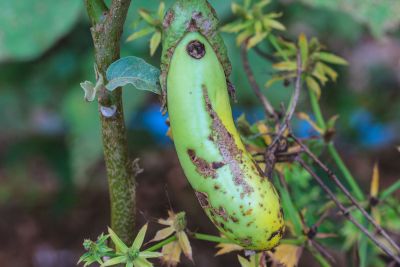Growing Eggplant
Eggplants are cold sensitive and shouldn’t be placed in the garden too early. Wait until the soil has sufficiently warmed and all threat of frost has ceased. These plants require full sun and well-drained soil amended with organic matter. When growing eggplants, space them about a foot or two (30.5-61 cm.) apart, as they can become rather large. Since eggplants are susceptible to many pests and diseases, the use of collars or row covers on young plants may be necessary to reduce common eggplant problems.
Dealing with Eggplant Pests
Lace bugs and flea beetles are common eggplant bugs. Other eggplant bugs that affect these plants include:
tomato hornworms mites aphids cutworms
The best way to deal with eggplant bugs is by using collars and row covers until the plants are large enough to withstand attacks, at which time insecticidal soap can be used to alleviate pest problems. To prevent eggplant bugs, it may also help to keep weeds and other debris to a minimum and rotate crops every other year or so. Introducing natural predators, such as ladybugs, often helps minimize eggplant problems associated with aphids.
Eggplant Diseases in the Garden
There are several eggplant diseases that affect these crops. Some of the most common include blossom end rot, wilt diseases, and various types of blight. Many of these eggplant diseases can be eliminated or prevented by practicing crop rotation, reducing weed growth, and providing adequate spacing and uniform watering.
Blossom end rot- Blossom end rot, as found in tomatoes, is caused from fungus due to overwatering and affects ripe fruit. Round, leathery, sunken spots appear on fruit ends with the affected fruit eventually dropping from the plant. Bacterial wilt- Bacterial wilt can cause plants to suddenly droop, from the bottom to the top, turning yellow. Affected plants eventually wither up and die. Verticillium wilt- Verticillium wilt is similar to bacterial wilt but is caused by soil-borne fungal infections. Plants may become stunted, turn yellow, and wilt. Southern blight- Southern blight is also caused by fungus and plants exhibit softening of the crown and root tissues. Mold may also be seen on the stems and surrounding soil. Phomopsis blight- Phomopsis blight usually affects fruits of eggplant, which begin as sunken spots that eventually enlarge and become soft and spongy. Leaves and stems, especially seedlings, may develop gray or brown spots first. Phytophthora blight- Phytophthora blight, which also affects peppers, can quickly destroy eggplants. Plants will get dark streaks prior to collapsing and dying.
